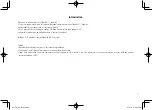
44
This phone has passed the MIL-STD 810G tests for multiple profiles; please go to
www.projectfreedom.com for the complete list. An independent laboratory that
conforms to U.S. military standards performed these tests.
Maintaining Water and Dust Resistance
This phone is resistant to water and dust when all compartments are closed tightly.
Follow these tips carefully to prevent damage to the device.
• Rinse the device with clean water after exposing it to salt water or ionized water.
• Do not immerse the device in water deeper than 1 meter and keep it submersed
for more than 30 minutes.
• If the device gets wet, dry it thoroughly with a clean, soft cloth.
• The SIM/microSD Card slot cover may be loosened slightly if the device is
dropped or receives an impact. Ensure that the cover is properly aligned and
tightly closed. Otherwise, it may not provide protection from water and dust.
• Always keep the Headset Jack and
USB/Charging ports clean and be careful to avoid damaging them. Do not attempt
to charge the phone when wet.
• If the device has been immersed in water and the microphone is wet, others may
not be able to hear you clearly during a call. Ensure that the microphone is clean
and dry by wiping it with a dry cloth and allowing the device to air-dry.
• Your device has been tested in a controlled environment and shown to be dust
and water resistant in certain circumstances (meets requirements of classification
IP68 as described by the international standard IEC 60529 - Degrees of
Protection provided by Enclosures [IP Code]. Despite this classification, your
device is not impervious to water damage in any situation. Splash, water, and
dust resistance are not permanent conditions and resistance might decrease as a
result of normal wear. Liquid damage is not covered under this warranty.
Safety information for wireless handheld phones
Read this information before using your handheld portable cellular telephone
Exposure to radio frequency signals
Your wireless handheld portable telephone is a low power radio transmitter and
receiver. When it is ON, it receives and also sends out radio frequency (RF) signals.
In August 1996, the Federal Communications Commissions (FCC) adopted RF
exposure guidelines with safety levels for handheld wireless phones. Those guidelines
are consistent with the safety standards previously set by both U.S. and international
standards bodies:
* ANSI C95.1 (1992)
** NCRP Report 86 (1986)
















































